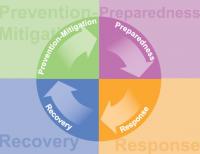Four Phases of Emergency Management

The premise behind the four phases of emergency management is to reduce the impact of emergencies on individuals and communities through appropriate preparation and response. Governments, schools and other agencies are adopting emergency management plans that encompass these four phases and ensure that they have comprehensive plans to address the impact of emergency situations. A list of resources on planning and responding to emergency situations is provided at the bottom of the page.
Phase 1 - Prevention/Mitigation
This describes activities designed to reduce or eliminate to probability of a disaster and to reduce the vulnerability of people and communities to the negative impacts of a disaster. Mitigation and Prevention seek to reduce the cycle of disaster damage and generally are intended for long-term sustained effects.
Phase 2 - Preparedness
This is the process of identifying the personnel, training, and equipment needed for a wide range of potential incidents, and developing jurisdiction-specific plans for delivering capabilities when needed for an incident. This phase represents a continuous process involving efforts at all levels of government and between government and private-sector and nongovernmental organizations to identify threats, determine vulnerabilities, and identify resources.
Phase 3 - Response
Response activities follow an emergency or disaster and are generally designed to provide emergency assistance for casualties (for example, search and rescue, emergency shelter, medical care, mass feeding). Response activities are focused on the short-term need, but also seek to reduce the probability of secondary damage resulting from the emergency situation(for example, shutting off contaminated water supply resources or patrolling an area with high risk for looting or community violence).
Phase 4 - Recovery
These activities constitute a comprehensive approach to restore the environment by addressing the social, environmental, political and economic aspects of the community. These activities initiate immediately following the response phase, or concurrently with the final aspects of that phase. They entail two levels of activities: (1) short-term recovery to return vital life support systems to minimum operating standards and (2) long-term recovery activities that may continue for several years following a disaster and seek to restore life to improved or functional levels.
Resources
The Readiness and Emergency Management for Schools Technical Assistance Center has a number of resources, trainings, distance learning events, and funding opportunities list on their Web site. Here are a few below that are particulary relevant to schools:
School Emergency Management Online Courses
Practical Information on Crisis Planning: A Guide for Schools and Community
Guide to School Vulnerability Assessments
Tips for Helping Students to Recover from Traumatic Events
